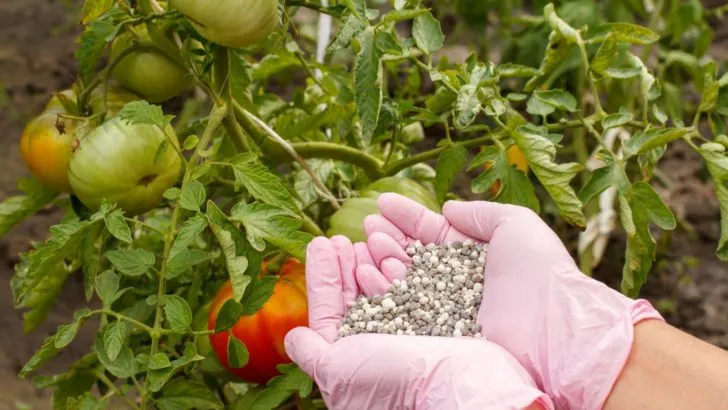When to fertilize tomato plants
Fertilizing tomato plants at the right time and with the appropriate nutrients is crucial for healthy growth and a bountiful harvest. Here’s a general guideline on when and how to fertilize tomato plants:
At Planting:
Before transplanting your tomato seedlings into the garden, mix in a balanced granular fertilizer (such as 10-10-10 or 14-14-14) into the soil. Follow the recommended application rate on the fertilizer package. This provides a good initial nutrient base for your plant. When your tomato plants are about 3-4 weeks old and have developed their first true leaves, you can provide a dose of nitrogen-rich fertilizer (the higher first number in the N-P-K ratio) to promote leafy growth. A balanced, slow-release fertilizer works well.
Mid-Season (After Transplanting):
Once your tomato plants start flowering and setting fruit, it’s essential to switch to a balanced fertilizer with equal or slightly higher levels of phosphorus and potassium (the second and third numbers in the N-P-K ratio). This encourages fruit development. Apply it every 4-6 weeks during the growing season.
Side Dressing:
Side dressing is the practice of applying fertilizer to the soil around the base of the tomato plants. You can do this during the growing season to provide additional nutrients. Scatter the fertilizer around the plant and work it into the soil lightly. Be cautious not to damage the plant’s roots.
Stop Fertilizing Before Harvest:
About 4-6 weeks before the expected first frost or when your tomato plants start ripening their fruits, stop fertilizing. This allows the plants to redirect energy towards fruit ripening rather than producing new growth.
Use Compost and Organic Matter:
Incorporating compost or well-rotted organic matter into your soil before planting is an excellent way to provide slow-release nutrients to your tomato plants throughout the growing season. It also improves soil structure and moisture retention.
Monitor and Adjust:
Regularly monitor your plants for signs of nutrient deficiencies or excesses, such as yellowing leaves (indicating a nitrogen deficiency) or excessive foliage growth with few fruits (indicating too much nitrogen). Adjust your fertilization schedule and choices based on your observations.
Why fertilizer is important for tomatoes
Fertilizer is crucial for tomato plants because it provides essential nutrients that are vital for their growth, development, and overall health. Tomatoes require a balanced supply of key nutrients, including nitrogen (N), phosphorus (P), and potassium (K), as well as secondary and micronutrients. These nutrients are essential for various plant functions:
- Nitrogen (N) promotes leafy growth and helps plants produce chlorophyll, which is necessary for photosynthesis.
- Phosphorus (P) is essential for strong root development, flowering, and fruit formation. It aids in energy transfer within the plant.
- Potassium (K) is crucial for overall plant health, improving disease resistance, and enhancing fruit quality.
- Secondary nutrients like calcium, magnesium, and sulfur, along with micronutrients like iron and zinc, play vital roles in specific biochemical processes.
Inadequate nutrition can lead to stunted growth, reduced fruit production, and increased susceptibility to pests and diseases. Proper fertilization ensures that tomato plants receive the right nutrients in the right amounts, promoting vigorous growth, robust fruit production, and healthier plants overall. It’s essential to select the appropriate fertilizer and follow recommended guidelines to optimize tomato plant health and maximize your harvest.
When is the best time to fertilize tomatoes?
At Planting: Before transplanting your tomato seedlings into the garden, mix a balanced granular fertilizer into the soil. This provides essential nutrients for the initial growth phase.
Early Growth (3-4 weeks after transplanting): Apply a nitrogen-rich fertilizer to promote healthy leafy growth, but avoid excessive nitrogen as it can lead to too much foliage and fewer fruits.
Mid-Season (when flowering begins): Switch to a balanced fertilizer with higher phosphorus and potassium content to encourage fruit development. Apply it every 4-6 weeks during the growing season.
Side Dressing: Optionally, you can side-dress with fertilizer during the growing season. Scatter it around the plant base and work it into the soil gently.
Before Fruiting (4-6 weeks before expected first frost): Stop fertilizing to redirect energy toward ripening existing fruits.
Organic Matter: Incorporate compost or organic matter into the soil before planting to provide slow-release nutrients.
What fertilizer do tomatoes need?
Tomatoes require a well-balanced fertilizer to thrive, one that provides essential nutrients in the right proportions. The three primary nutrients required by tomatoes are nitrogen (N), phosphorus (P), and potassium (K), often represented as the N-P-K ratio on fertilizer labels. The recommended N-P-K ratio for tomatoes is typically around 5-10-10 or 10-10-10.
- Nitrogen (N): Nitrogen promotes lush vegetative growth and green foliage, which is vital early in the growing season. However, too much nitrogen can result in excessive foliage at the expense of fruit production, so it should be balanced with phosphorus and potassium.
- Phosphorus (P): Phosphorus is essential for strong root development, flower formation, and fruit set. It aids in energy transfer within the plant.
- Potassium (K): Potassium is crucial for overall plant health, helping with disease resistance and fruit quality.



